L.I.R.R. MAINTENANCE OF WAY
EQUIPMENT
by
Nick Kalis
| How equipment enters MOW service
makes for an interesting story. There have been periods when certain
types of equipment became surplus either by law or by the advent of more
modern equipment. As streamline passenger equipment
appeared, surplus heavyweight cars were often turned into
employee bunk cars. In the late 1940s, as diesels replaced steam
locomotive, tenders were often salvaged to store water or fuel. It seems
the LIRR owned at least one example of each of the
|
| Early
Practices |
| Earlier years on the
As late
as 1922, LIRR employees operated an oil train to spread oil on the
railroad's right of way both to retard vegetation and control dust (see
Ziel, pages 70-71). Work trains even used
wooden coaches at one time as evidenced by a 1904 photo in
Ziel page 79. G-53 ( A great deal of information about LIRR work
equipment in 1916 is available but was omitted from this article for the
sake of brevity and on the assumption that most modelers are interested
in more modern eras. |
|
Work
Equipment owned by the LIRR
as of
|
|
Type |
Unit
Numbers |
Total |
|
|
Burro Cranes |
432, 85207, 85208 |
3 |
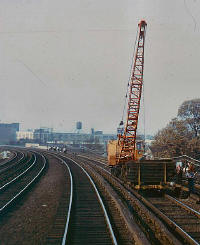 #85208 |
|
Locomotive Cranes |
171, 172, 184, 198 |
4 |
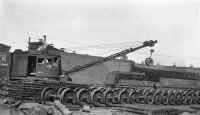 LIRR Rail crane #198 swinging wheels into LIRR gondola #2953 - Morris Park Shops - Queens, NY - 9/27/1915 Archive: Dave Keller |
|
Instruction Car |
I10-I12 Instruction "training" car where conductors and engineers qualified; located on the east end of yard D in Jamaica. Later moved to the Johnson Ave yard.
I10 Built 1915 Acquired
11-62 |
3 |
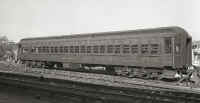 PRR Instruction car #492443 Jamaica 1952 Archive: Dave Keller
|
|
Wreck Derrick
|
197 Built
by Brownhoist: 4/1926
|
1 |
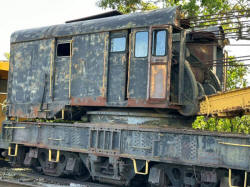 ex-LIRR 197 at Black River & Western Ringoes, NJ 9/21/2023 Photo/Archive: Tim Darnell 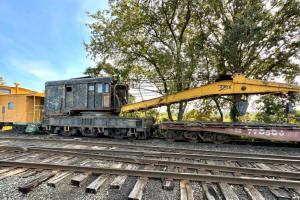 |
|
Work Train Cars |
W-50, W-51, W-52, W-53, W-54, 492512, 489589
Retire: W-51
W-52 W-53 W-54 and replace by RPO 7717 and 7737 converted for wreck train
service. Dispose of: RPO 7743 7751 7752 7753 |
7 |
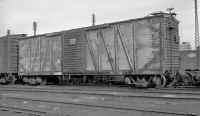 LIRR #489589
|
|
Boom Cars
|
241, 491577, 491986 |
3 |
|
|
Jordan Spreader-Ditcher - Snow
Plows |
497498, 497499 |
2 |
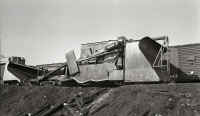 497498 Holban Yd Hollis 2/06/1949 Archive: Dave Keller 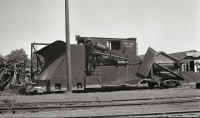 497499 in yard Hicksville 7/25/52 Archive: Dave Keller |
|
Steam Rotary Blower & |
193, 499151
|
2 |
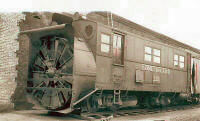 Cooke rotary #193 Morris Park 1898
|
| Long Island Railroad, Rotary Snowplow #193. Built at Cooke Locomotive and Machine Works, Paterson, NJ November 1898 with builder's number 55. Present tender is a Pennsylvania Railroad tender that replaced the original wood-frame tender after 1940. Number 193 was retired in 1965. The plow was purchased by private owners in 1968 and sold to the Steamtown Foundation in 1988. It remained in one place in New Jersey from 1968 until Conrail moved the rotary plow to Steamtown NHS in July 1993. Only surviving steam rotary snowplow known to have been used on railroads east of the Mississippi. | |||
|
Snow Plows (Ray Type) |
#2-5 renumbered #189-192
|
|
|
|
Snow
Flanger Cars |
495744, 495745, 495746, 495772,
495773, 495791, |
8 |
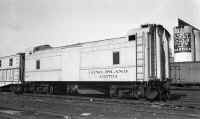 #495793 Snow Flanger, Holban Yard, Hollis 2/06/1949 Photo: George Votava Collection: Keller |
|
Work Train Cars |
W11, W12, 491598, 491600, 491976, 491985, 494954, 494955, 494956
|
9 |
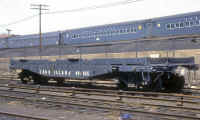 LIRR #491985 Tool Car flat - Richmond Hill 3/31/64 (Rugen-Huneke) |
|
Train Riding Car |
492754 |
1 |
|
|
MOW
|
492761, 492763, 492764, 492765, 492766
|
5 |
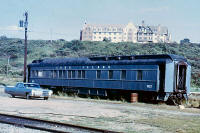 Dormitory W37 Montauk c. 1970+ Photo: Steve Hoskins This
dormitory car is different from the MOW bunk cars, in that those cars were
only occupied by trackmen during major repairs, i.e. derailments, etc. and
they moved from one site to another as required. The car in
Montauk was It was a
bunk car for parlor and bar car attendants during long layovers.
“Although
it was not a revenue car, the crew dormitory at Montauk Yard is worthy of
inclusion here. LIRR bought |
|
Tool
& Supply Cars
|
498571 to 498574 inclusive |
4 |
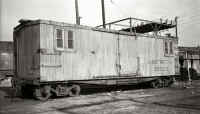 Tool car #498573 - Dunton Electric Car Shop 11/29/47 Archive: Dave Keller
|
|
Carrier Car for MOW |
491601 |
1 |
|
|
Idler
Cars |
434903, 497983, 497993, 497999 The idler car in use with the DD1 electrics was for 3rd rail continuity on freight trains. These cars had third rail shoes. The same style car, with no doghouse atop the flatcar without 3rd rail shoes, were used with steam and later diesel at the float docks.
|
4 |
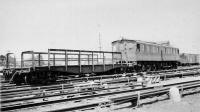 |
|
Hopper Car for Cinder and
Ballast |
494764 |
1 |
|
|
Steel Ash Cars
(For
|
494781, 494782 |
2 |
|
|
Gondola Cars (For Rubbish, Scrap, etc.)
|
494905, 494908, 494912, 494923, 494925, 494934, 494950, 494951- 494953, 494957, 494961, 494963- 494970, W1-W10
|
|
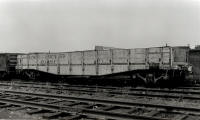 #494964 Holban 07/05/54 Photo: Votava Collection: Keller
|
|
|
Total Work Equipment, cars,
etc. |
91 |
|
P. H. Hatch, General Mechanical Superintendent
| Until the mid-1950s one of the
LIRR cabin cars, which had been box cars, was painted grey and used on
work trains, Art Huneke recalls. By
|
|
Work
Equipment owned by the LIRR
as of 1965
by James Gillin |
|
Type |
Unit Numbers |
Total |
|
|
Locomotive Crane |
200 |
1 |
|
|
Wreck Crane |
197* |
|
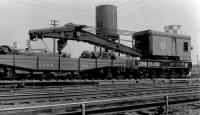 W50 tending W197 Morris Park 8/15/58 Photo: G. Votova |
|
Wreck Train Cars |
W-50*, W-56, W-57 |
3 |
|
|
Tool Cars |
W-55, 491985 |
2 |
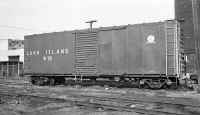 W-55 LI City, NY 05/03/1960 Photo: George Votava Collection: Dave Keller |
|
Jordan Spreader |
W-93
|
1 |
|
|
Boom Car |
491577 |
1 |
|
|
Steam Rotary & |
W-14*, 193* LIRR
Rotary Snowplow #193; built by Cooke Locomotive and Machine Works, 1898
(weighs 67.5 tons with a 9 foot, 8 inch blade assembly) Tender is a 1940
PRR replacement of the original wood tender |
2 |
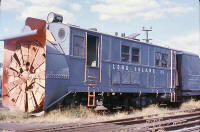 #193 at Steamtown, PA |
|
Snow Plow |
W-80, W-83* W80
and W83 were both built by the LIRR shops in December, 1915 atop 1907
flatcars. They
were both renumbered in January, 1960
|
2 |
Archive: Dave Keller |
|
Instruction Car |
I-10, I-11, I-12 |
3
|
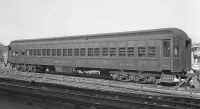 PRR #492443 on the storage track at Jamaica station Class P70 1952 Photo: George Votava Collection: Dave Keller
|
|
Snow
Flanger Car |
W-84, W-86, W-89, W-91 |
4 |
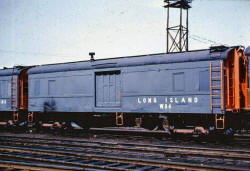 W84 Snow Flanger Car - Morris Park |
|
Float Reacher Car |
W-23, W-27, W-29, W-39, W-70 Note: I would rather think that that was NOT a reacher car for the floats. The float flats, as we called them, had a little shanty on them that had a pot belly stove and benches for the crew to get out of the cold. This one without the shanty would have been used on the east end ladder job as a car to improve vision for the engine crew while rolling the hump. That job continued for some time after the floats stopped operating. Freight came in from Fremont that needed classifying.
The car in question, however, WAS referred to as a float flat. JJ
Earl |
5
|
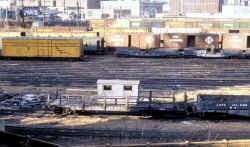 Reacher Car- W-27 with Gondola W-5, Welded Rail Flats R-3, R-34 in background at LI City 1/1973 Photo/Archive: Art Huneke |
|
Gondola Car |
W-1, W-4, W-5, W-8, W-9, W-10,
|
24 |
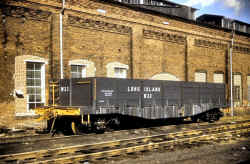 W-22 Morris Park 1958 (Rugen-Huneke)
|
|
Welded Rail Car |
R-3, R-6, R-7, R-15, R-18, R-30, R-31, R-33, R-34, R-40, R-41, R-42, R-43, R-44, R-45, R-46, R-47, R-48, R-49, R-50, R-51, R-52
|
22 |
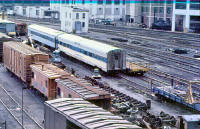 Welded Rail Car (far right) Yard A 5/1976 Photo: Tim Darnell
|
Equipment marked with an "*" appear in color
in:
Volume 5: N.E. Railroad Work Equipment, Classic Freight Cars,
The Series
|
MOW
Storage Car |
W-2
MES (Maintenance of Equipment Storage) ex-LIRR #2
caboose |
1
|
|
| Fuel Storage Car | W-88, W-89, W-90 MWM ( Store-Supply car equipped for handling material to be distributed for railway use) Acquired 10/1973 | 3 |
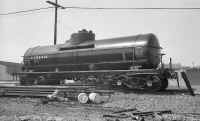 W-88 Morris Park Yard 4/20/74 Photo: George Votava Collection: Dave Keller |
| Brush Car |
A brush car cleaned off the 3rd rail. BTW: This car is laying up at East Williston, because that was (and is) the extent of electrification on the Oyster Bay branch. Withdrawn from service between 1950 and 1955. This one was shot at East Williston on 5/1/54. I doubt ANY were renumbered “W-XX”. Built by ACF 1910. Info: Dave Keller
|
1 |
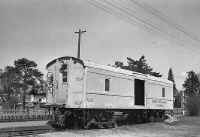 #498846 siding across E. Williston Station 05/07/1954 Photo: Ed Hermanns Collection: Dave Keller |
| Rail Road Vehicles |
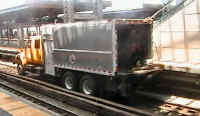 Photo: Tim Darnell |
1 |
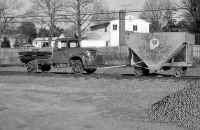 New electric yard near end of construction - Ronkonkoma - 12/1987 Photo: Dave Keller |
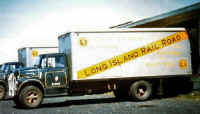 "Rail Way Best Way" Slogan LIRR Trucks |
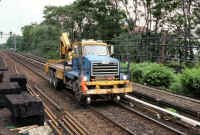 MOW TC016 Railroad Truck on Main Line at Woodside - 5/17/1991 Archive: Dave Keller |
||
 MOW lineside truck at Holban South yard - 7/1976 Photo/Archive: Tim Darnell |
|||
|
Ore Jennies Ore Cars |
They were used in removing tunnel boring excavated rock from the Third City Water Tunnel, Queens section. Loaded out in Maspeth where the LIRR used to have a freight house on Grand Avenue. There was a ban on shipping this material by truck from the Queens job site, so the railroad got the business. Cars extensions for use in hauling taconite pellets. Not as dense as iron ore. Former CN and BN cars. The LIRR sold them to LS&I who shortened the cars. String of cars in Yard A were bad order cars/part sources for the rest of the fleet. They got scrapped when the others were sold. Info: John McCluskey |
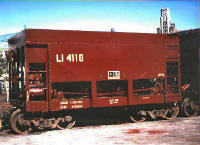 LIRR #4188 Ore Jenny (tunnel boring debris)
|
|
|
LIRR MOW Ore Cars:
Further
Info and Photos |
|||
| Ballast
Spreader |
|||||||||||||||||||||||
| As late as 1956, the
|
|||||||||||||||||||||||
| Bar
Generator Car |
|||||||||||||||||||||||
| LIRR #2103 rebuilt as bar-generator cars to provide trainline power to cars operating in the consist of trains without a powerpack cab control unit. | |||||||||||||||||||||||
|
|
|
||||||||||||||||||||||
| Boarding
Outfit/Bunk Cars |
|||||||||||||||||||||||
| By 1965, boarding outfit cars ( |
|||||||||||||||||||||||
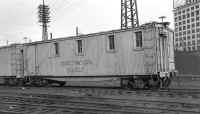 Crew Car #492513 LI City 07/22/1950 Sunshine Biscuit Co. at right, view SW Info: Ed Schleyer |
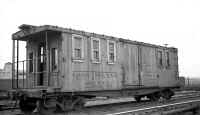 Crew Car #492755 with Platform Holban Yard 11/02/1947 Archive: Dave Keller |
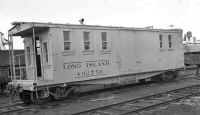 Crew Car #492756 Holban Yard c.1947 Archive: Dave Keller |
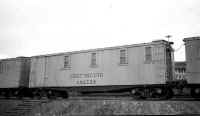 Crew Car #492758 Holban Yard 11/22/1947 Archive: Dave Keller |
||||||||||||||||||||
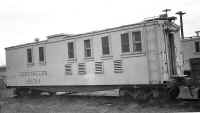 Crew Car #492764 Holban Yard 11/22/1947 Archive: Dave Keller |
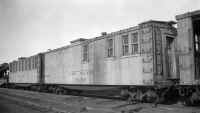 Crew -Cars #492760 & 492759 Holban Yard c.1947 Archive: Dave Keller |
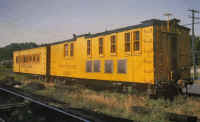 PRR MOW Crew- Cars Harrisburg, PA June, 1965 Provided ONLY to show the actual color scheme of these cars when in service. Courtesy of The Keystone, Archive: Dave Keller |
|||||||||||||||||||||
| Boom Cars | |||||||||||||||||||||||
| Typically, railroads supply each crane with a boom car to protect its boom while it is lowered and in transit. Railroads select boom cars first for the necessary length to accommodate the boom. Then they are fitted with hardware and needed appliances. In 1973, LIRR management kept Wreck crane W-75 along with idler car W-50 at Morris Park Engine Terminal. | |||||||||||||||||||||||
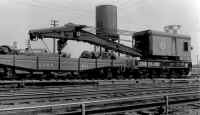 Boom tender flatcar W-50 with W-197 wreck crane at Morris Park
8/15/1958 Photo: G. Votova
Boom tender flatcar W-50 with W-197 wreck crane at Morris Park
8/15/1958 Photo: G. Votova |
|||||||||||||||||||||||
| Chloride
Cars |
|||||||||||||||||||||||
| EX-BAGGAGE/EXP: #641-#645 CONVERTED: 1934-35 #497100-#497104 Former baggage express cars with 3rd rail shoes added. | |||||||||||||||||||||||
|
|
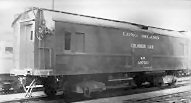 #497101
#497101
|
||||||||||||||||||||||
| Cranes | |||||||||||||||||||||||
| LIRR "crane" number 197 is more properly called a derrick as the 1956 roster described it because of its short boom style. Cranes differ from derricks (MWW: Wreck Derrick, propelled by locomotive, used for heavy lifting) in several ways. Cranes have long spindly booms for use with drag lines, electromagnets, and clamshells. Whereas derricks are husky, short boom style cranes one would see cleaning up a train wreck and sometimes known as the big hook or auxiliary. Cranes are typically used for everyday maintenance work while Derricks are used only for emergency work. | |||||||||||||||||||||||
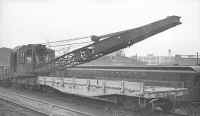 #490999 #490999
|
|||||||||||||||||||||||
| Double-end Wedge Plow | |||||||||||||||||||||||
|
Double-end wedge plow/spreader #s 497762, 497763 Acquired: 1935 Withdrawn from service: c. 1953-54 Research: Dave Keller |
|||||||||||||||||||||||
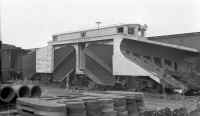 Votava's
photo shows a stenciled notation that reads "repacked:
11/15/52." Votava's
photo shows a stenciled notation that reads "repacked:
11/15/52." This photo was taken in 1954 and shows the plow rotting as well as being cannibalized, so I've given the WFS date as c. 1953-54. Info: Dave Keller Double-End Wedge Plow-Spreader # 497762 |
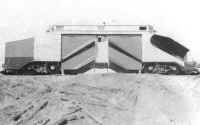 Double-ended
Wedge Plow #497762 (Votava-Boland) Double-ended
Wedge Plow #497762 (Votava-Boland) |
||||||||||||||||||||||
| Flat
cars |
|||||||||||||||||||||||
| While they surely appeared
earlier, Flat cars, known as
|
|||||||||||||||||||||||
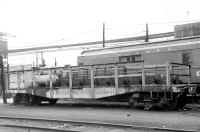 #499999 Pump flatcar LI City 10/1947 Archive: Dave Keller
#499999 Pump flatcar LI City 10/1947 Archive: Dave Keller
|
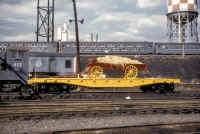 #494976 with 1885 farm wagon replica piggyback "Farmers
Train". Done for an industrial exhibition at Roosevelt Raceway.
Morris Park 10/1960 (Rugen-Keller)
#494976 with 1885 farm wagon replica piggyback "Farmers
Train". Done for an industrial exhibition at Roosevelt Raceway.
Morris Park 10/1960 (Rugen-Keller)
|
||||||||||||||||||||||
| Gondola Cars | |||||||||||||||||||||||
| The
LI 6050-6086 Gondola GBS Class - Specialty Open top car, having fixed sides, fixed or drop ends and solid bottom. |
|||||||||||||||||||||||
 Class GB LI #6057 09/30/2007 Photo: John McClusky
|
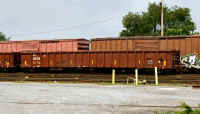 LI #6078 Photo: Paul Strubeck |
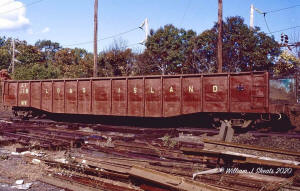 LI #119 MOW gondola Sayville 10/12/1999 Photo/Archive: William Skeats |
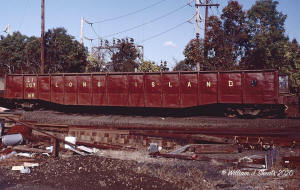 LI #107 MOW gondola Sayville 10/12/1999 Photo/Archive: William Skeats |
||||||||||||||||||||
|
The 66' gondolas, 15-20 series 6200’s, open ended for
welded rail recovery. AAR Clearance Plate C with cushion couplers
on each end. Built Dec 2023-Jan 2024 by Ebenezer Railcar Services
in Buffalo, NY. |
|||||||||||||||||||||||
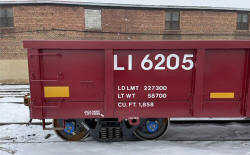 LI #6205 gondola Photo/Archive: Barry Johnson -NRHS LIST |
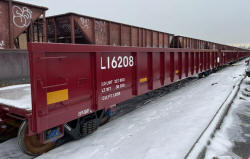 LI #6208 gondola Photo/Archive: Barry Johnson - NRHS LIST |
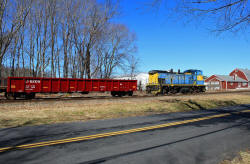 The 166 sits uncoupled from a train of brand new open-end gondolas, #6205, brought out to AH in advance of trackwork on the eastern reaches of the mainline in Calverton 3/03/2024 Photo/Archive: Ronnie Schnepf |
|||||||||||||||||||||
| Hoppers: More info page | |||||||||||||||||||||||
| LI 6100-6162 Within the 6100-6162 series 13 rib we have early delivered version and an extended version: LI 6160-6162 15 rib series LI Ballast Hoppers Class HT: Open top self-clearing car, having fixed sides and ends and bottom consisting of three or more divided hoppers with doors hinged crosswise of car and dumping between rails. | |||||||||||||||||||||||
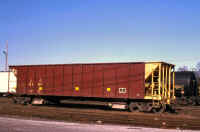 LI #6131 Fresh Pond Jct. 11/11/99 |
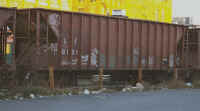 LI #6161 15 rib extended version 10/21/2007 Photo: John McCluskey |
|
|||||||||||||||||||||
| LI 100015-100034 The series 100015-100034 has 11 ribs with 3 center ribs close together HT: Open top self-clearing car, having fixed sides and ends and bottom consisting of three or more divided hoppers with doors hinged crosswise of car and dumping between rails. |
|||||||||||||||||||||||
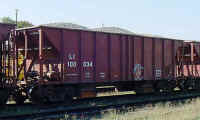 LI #100034 Port Jefferson 9/21/2003 Photo: John Volpi
LI #100034 Port Jefferson 9/21/2003 Photo: John Volpi
|
|||||||||||||||||||||||
|
Instruction Car |
|||||||||||||||||||||||
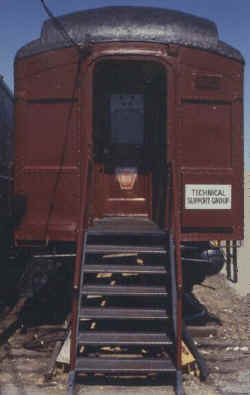 In 1953, Pullman Standard
delivered as lot 6911, plan W52354 twenty 128-seat commuter coaches for
intermediate (non-control) use. All were retired save for one retained
as instruction car I-121, according to Randall's Official
Pullman-Standard Library, Volume 10 Northeast Railroads. Can any
reader identify how long this car served and In 1953, Pullman Standard
delivered as lot 6911, plan W52354 twenty 128-seat commuter coaches for
intermediate (non-control) use. All were retired save for one retained
as instruction car I-121, according to Randall's Official
Pullman-Standard Library, Volume 10 Northeast Railroads. Can any
reader identify how long this car served and what sort of instruction was offered? Technical Support Group LIRR Training Car 1981 |
|||||||||||||||||||||||
| Misc.
Equipment - Trucks, Buses, SUVs, Etc. |
|||||||||||||||||||||||
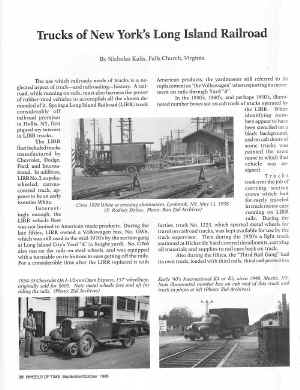
|
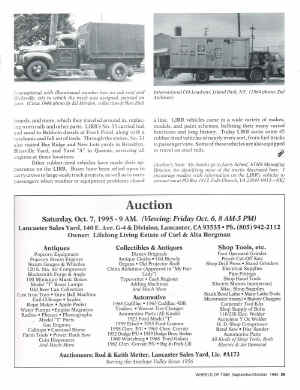
|
Vehicle Letter Designations T Track Department |
|||||||||||||||||||||
| LIRR "Trucks of New York's Long Island Railroad" ATHS: Wheels of Time pages:28-29 9/1995 Author: Nick Kalis Collection: Charles Geletzke | |||||||||||||||||||||||
|
|
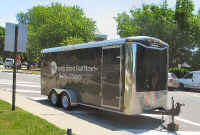 LIRR Traffic Control trailer 6/20/2007 Photo: Kuzzel
|
|
That's the welding gang. Normally they work around the clock and handle emergency track repairs. It is a very senior crew. Track Foreman, welder and two trackmen. Very highly paid and experienced guys who can fix anything short of a major wreck. Their boss is the Supervisor of Track. |
||||||||||||||||||||
|
|
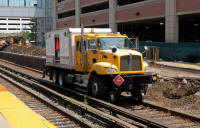 LIRR 225T Thermite welding truck - Mineola 7/11/2020 Photo/Archive: John Ciesla
|
|
|
||||||||||||||||||||
 |
 |
 |
|||||||||||||||||||||
| MOW trucks at Arch St. Yard, LI City - 7/2025 Photos/Archive: Chris Kokonis | |||||||||||||||||||||||
| Naphtha Fuel Gas Cars | |||||||||||||||||||||||
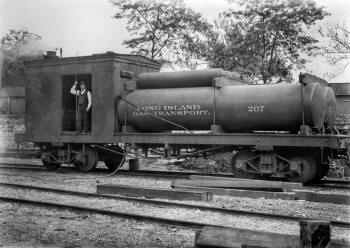 Pintsch
compressed fuel gas distilled from naphtha designed specially for the
illumination of railroad cars. Pintsch
compressed fuel gas distilled from naphtha designed specially for the
illumination of railroad cars. Appears as MOW Gas Transport #207-208 LIRR Official Railway Equipment Register (ORER) 1904, #207 listed in 1917 Photograph taken of LIRR Pintsch gas transport car No. 207 at Jamaica Station, near Archer Avenue and Sutphin Boulevard in Jamaica, Queens in 1904. Photo: Harold B. Fullerton Collection: Queens Public Library Digital Collection |
|||||||||||||||||||||||
| Oil Sprinklers | |||||||||||||||||||||||
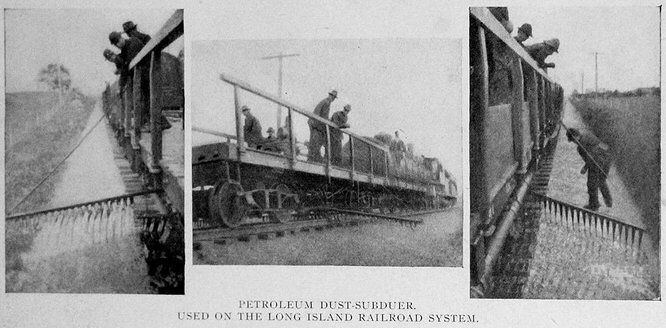 Oil Sprinkler car #149 photographed, 1899, by H. B. Fullerton, Public Relations. LIRR MOW petroleum oil sprinkler dust and weed control at work. |
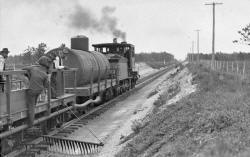 Oil Train at Central Islip - 1899 Photos: Hal Fullerton 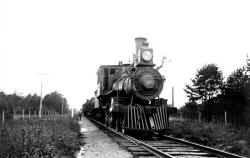 |
||||||||||||||||||||||
|
Paint Schemes |
|||||||||||||||||||||||
| Mike Boland, the foremost expert
on this subject, authors "Long Island Railway Modeler" a monthly column
in the Long Island Sunrise Trail Chapter - NRHS Semaphore. Mike
Boland writes that "the
|
|||||||||||||||||||||||
| Pile Driver Car | |||||||||||||||||||||||
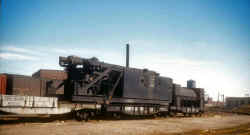 Steam Pile Driver #222, tender #240, flatcar #491957 Richmond Hill 1949 (Rugen-Huneke) |
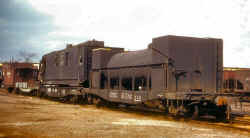 Steam Pile Driver #222, tender #240 Richmond Hill 1949 (Bill Rugen-Art Huneke) |
||||||||||||||||||||||
| Poling
Cars |
|||||||||||||||||||||||
|
|
These cars allowed a switching crew to work three tracks from the center track saving time in switching. Poling cars represented a safety advance over wooden poles positioned by a brakeman between the poling pockets on the car and the locomotive’s pilot beam. According to the PRR Classification of Cars No. 146-D, the S-5 steel poling car design was adopted in 1913. The 25 ft. long S-5, had a total weight of 51,000 lbs. which is a lot, compared to a 40 ft. Class X25 Steel Box Car’s 49,100 lbs. Info: David J. Vinci | ||||||||||||||||||||||
| Portable Substations | |||||||||||||||||||||||
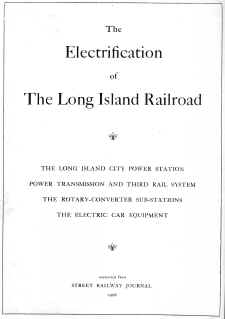 |
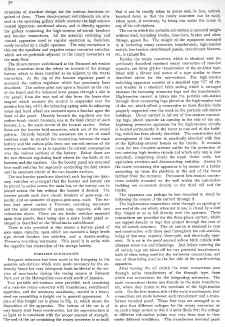 |
|
|
||||||||||||||||||||
|
The Electrification of The Long Island Railroad - Street Railway Journal, 1906 |
|||||||||||||||||||||||
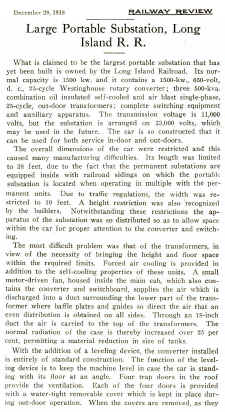
|
LIRR
PORTABLE SUBSTATION CARS: Builder:
American Car & Foundry Co: 1906 1.
Manufacturer per stenciled name on wheel as seen in builder's photo 2.
Date and quantity per Street
Railway Journal of 1906 3.
Numbered cars 1 and 2 4.
Still listed on the 1917
Official Railway Equipment Register / Long Island Railroad
(one word) p. 176, indicating cars 1 & 2. Cars either replaced or two more added per Railway Review (12/28/1918) 1.
Builder: Railway
& Industrial Engineering Co. - 1918 I
believe these cars may have been the cars that later were numbered
70553, 70554 (photographic
evidence) c. 19__?___ Cars
70553, 70554 also bore concurrently numbers 3 and 4 (photographic
evidence 1957) and were later renumbered to S1, S2 (photographic
evidence) c. 1960. I have
no idea of the disposition of the American Car & Foundry Co. car 2
(and possibly car 1?).
|
||||||||||||||||||||||
|
Large Portable Substation, Long Island Rail Road - Railway Review, 1918 |
|||||||||||||||||||||||
|
|
|
|
|
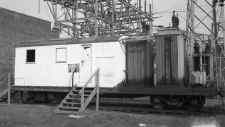 Portable substation Car at W. Hempstead 4/23/72 (Votava-Keller)
|
|||||||||||||||||||
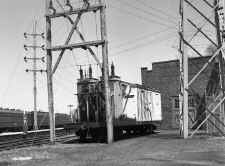 Portable substation Car - W. Hempstead at LIRR substation #6 4/20/1969 Archive: Dave Keller |
|
||||||||||||||||||||||
| Radio Repair Car | |||||||||||||||||||||||
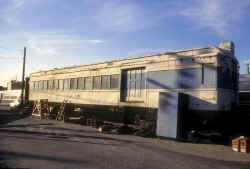 W-6
ex-MPB54 #1398 Radio Repair car at Johnson Ave Yard, Jamaica 1978
Archive: Art Huneke W-6
ex-MPB54 #1398 Radio Repair car at Johnson Ave Yard, Jamaica 1978
Archive: Art Huneke |
|||||||||||||||||||||||
| Reacher
Cars The |
|||||||||||||||||||||||
|
Equipment roster
10/01/65, the following five in use: |
|||||||||||||||||||||||
|
|
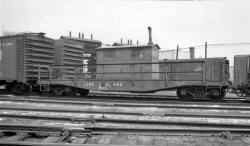 W23 at LI City car floats - View NW 6/10/1967 (Votava-Keller) |
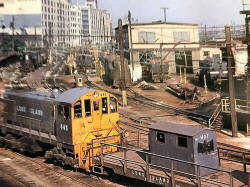 W27 Yard A, LI City - S2 #446 Nickname "Batman" c.1970 |
|||||||||||||||||||||
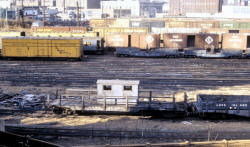 W27 LI City - View N 1/1973 Archive/Photo: Art Huneke
|
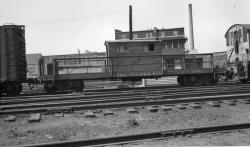 W39 Yard A LI City view N 5/25/1963 (Votava-Keller) |
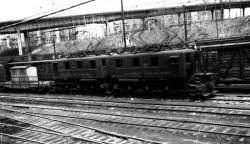 Reacher car LIRR B3 #337 #325 Bay Ridge 4/08/1946 |
MORE: Reacher Idler Cars |
||||||||||||||||||||
| Sand Service | |||||||||||||||||||||||
|
|
|||||||||||||||||||||||
| Preston Cook (see "Sand Service
Cars", RMC, August 1987 pp.86-87) writes that "most railroads
have fleets of specialized covered hopper cars set aside strictly for
the transportation of locomotive sand. These hoppers are generally two-bay,
or very small three-bay cars." I uncovered no such covered hoppers in
use with the
|
|||||||||||||||||||||||
| Side Dump Cars | |||||||||||||||||||||||
| LI 6001-6005 Diffco Side Dump Class MWD - Dump Cars. On the type of contractors' car used for building up fills; the body of the car dumps being raised by means of counterweight, air or hand power. | |||||||||||||||||||||||
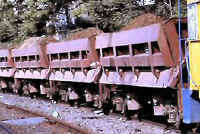 Diffco MOW 6000 series Yard A c.1990 |
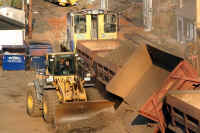 LI #6004 at wash track and runaround track at Hunterspoint Avenue. The location is just SE of the station. c.1990 |
||||||||||||||||||||||
| Steam Power Cars | |||||||||||||||||||||||
| Parked on a unused siding in a yard, connected to the steam piping buried in the yard, and plumbed to a water source to heat passenger cars laid up, keeping the onboard water systems from freezing. They may have had two steam generators installed. Also, used at times as a track washer, the steam sprayed under pressure to remove debris from the rails/trackbed while connected to at least 4-5 tank cars of water. | |||||||||||||||||||||||
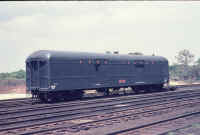 W94 Speonk 6/1969 Photo: Jim Gillin
|
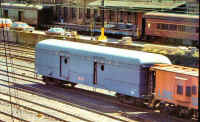 W94 c.1980 Photo: Tim Darnell
|
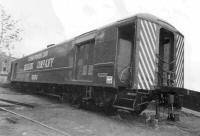 Reading #92100 Steam Power car c.1962 Originally a baggage car converted to a steam power car. Posted: eBay
|
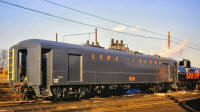 W95 Freshly painted at Morris Park Shops Receiving Yard Track #8 1/1969 Archive: Dave Keller
|
||||||||||||||||||||
| Storage Supply cars | |||||||||||||||||||||||
|
The LIRR used available cars converted to MOW usage as
storage supply cars for track work, the Electric Dep't, and 3rd rail
work, for example. Info: Art Huneke |
|||||||||||||||||||||||
|
|
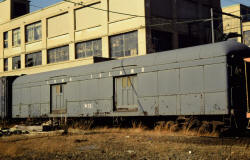 W72 a previous baggage car #7721 at Morris Park Photo/Archive: John Scala late 1970's |
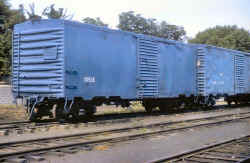 Storage utility car #10586 #3504 Morris Park 6/27/65 (Rugen-Huneke) |
|||||||||||||||||||||
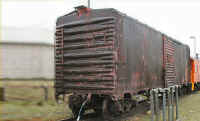 LIRR #100 Garden City Yard c. 1998 Archive: OBRM |
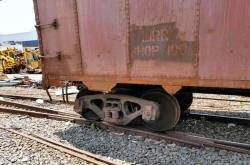 LIRR SHOP #100 ex-NH-40'-boxcar 6/2021 Steve Torberg |
||||||||||||||||||||||
| Snow
Removing Equipment |
|||||||||||||||||||||||
| The
LIRR Snow flanger car W-84 is a converted electric MU coach that sprays alcohol on third-rails as a de-icer. Huneke recalls that the LIRR had a tank car in recent years to store the alcohol used in W84. Two other alcohol cars were ex- Boston & Maine and later LIRR coaches.
Jet Snow Blowers: LIRR seemed to have
reused the same numbers for the Jet snow blower. The first (TC900)
arrived in 1967 as shown in the LI Railroader Issue 12/28/1967 photo
below. |
|||||||||||||||||||||||
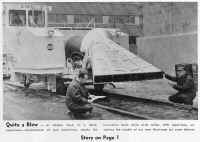 The first TC90 arrived in 1967 Archive: Al Castelli |
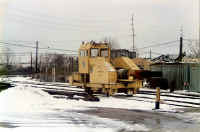 TC990 Thunderbolt Hicksville Feb 9, 1986 |
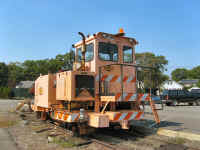 TC990 in West Babylon 9/26/2007 Photo: Al Castelli |
|||||||||||||||||||||
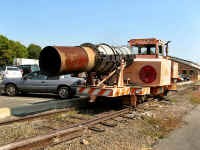 TC990 in West Babylon 9/26/2007 Photo: Al Castelli |
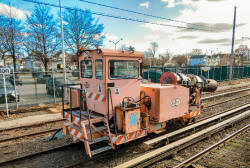 ESSCO TC-990 in Port Washington 12/23/2021 Photo/Archive: Craig Lignelli |
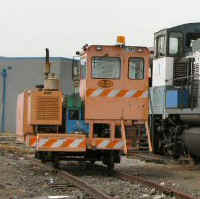 TC990 Morris Park Shops Bone Yard 03/28/2009 Photo: Richard Lalomia |
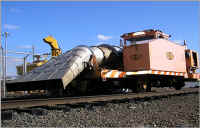 12/2010 |
||||||||||||||||||||
|
AF1 Snow Blower in action 12/25/2010 |
|||||||||||||||||||||||
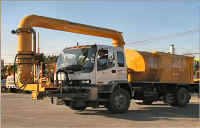 |
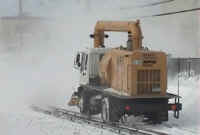 |
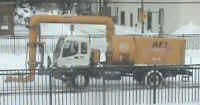 |
|||||||||||||||||||||
| Test Weight Car | |||||||||||||||||||||||
|
|
|||||||||||||||||||||||
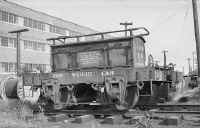
|
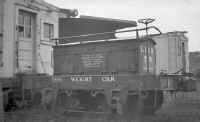
|
||||||||||||||||||||||
| Tool
Cars |
|||||||||||||||||||||||
|
The
Many tool cars never leave their assigned
location, especially if the gang they are assigned to has a small
territory and is highly mobile. I have assumed the LIRR also followed
this practice. Anyone with contrary information is encouraged to
respond.
|
|||||||||||||||||||||||
|
Track Vehicle - VW's VW track vehicles: #1035 (stenciled "Gandy Wagon" ), #1036, #1040 and #1041. |
|||||||||||||||||||||||
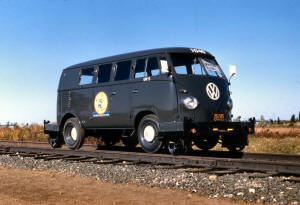 VW "Gandy Wagon" GW-5 Track Inspection Car #1040 9/1960 Photo: Henry Maywald Archive: Dave Keller |
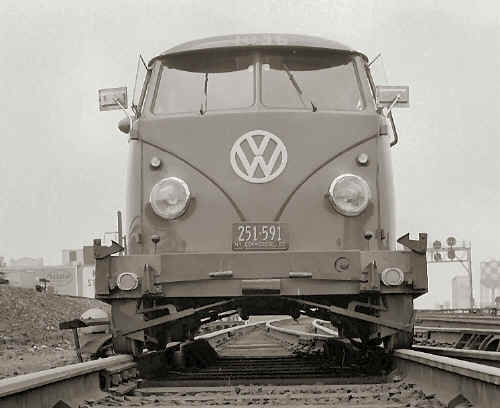 LIRR VW #1036 track vehicle 1960 view W Track 9 Jamaica near Jay Tower |
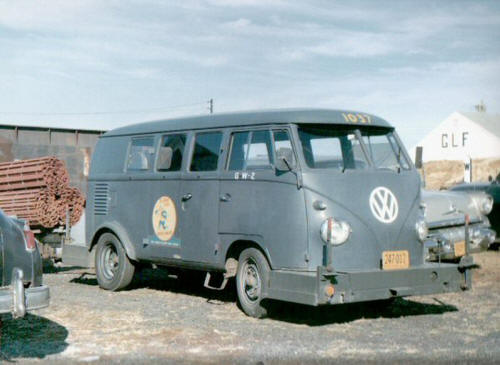 MOW VW #1037 Bridgehampton 1/15/1962 Photo: Norman E. Kohl Archive: LIST-NRHS
|
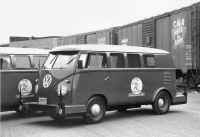 VW Rail Bus #1036 inspection car Collection: Art Huneke |
||||||||||||||||||||
| Track
Inspection Cars Note: Sperry Rail Service Inspection Cars check rails with a form of ultrasound for cracks inside the railhead. Plasser Track Geometry Cars check rail beds, how the rail is held and reacts under load, check gauge, banking, and deflection, etc. 6/08/2008 |
|||||||||||||||||||||||
|
|
SRS 126 and 140 both electronically scanned the inside of steel rails to detect internal flaws, which were either innate or the result of wear and tear. In the days of these photos, the LIRR would contract with Sperry to test the entire RR yearly. These days they do it at least thrice yearly. Both detector cars utilized two different systems for detection: an ultrasonic system which used high frequency sound like sonar, and a magnetic induction system which induced a current into the rail to create a magnetic field and then measure anomalies in the field which would represent internal flaws. The latter system was the original system invented by Dr. Elmer Sperry in the early twenties. SRS 126 and many of its sisters were built on second hand gas-electric passenger vehicles that many roads used for passenger service on branch lines during the late twenties and into the very early 50's (kind of the forerunner of the Budd RDC's). SRS 140 was a relatively brand new car in this photo and was built into a NYCTA car body so that it could also be run over the TA's rails, as the older cars like SRS 126 wouldn't fit TA clearances. Prior to the 140 class, SRS used a remodeled Mack Railbus equipped with just an ultrasonic system for detection on the TA. In the pictures we're looking at, the head end of the SRS 126 and the rear end of the SRS 140. Cars detected only in the forward mode which made for lots of deadheading on multiple track branches. Both cars were only operated from the head end. However, they could operate MAS backwards, with an operator on the head end and with the operator on the rear end signaling on a buzzer system to the head end. Eventually all the cars were converted to diesel electric; much to my disappointment. I loved it when the gas electrics idled and unburnt gasoline fumes would collect in the 3 stacks; so that when the operator pulled back on the accelerator handle, three to four foot flames would erupt from the stacks...such fun! Photos/Info: Win Boerckel Archive: Dave Morrison
Note: Sperry #126 was numbered 9900
and in service as a gas car/"doodlebug" on the C&NW at Belvidere, IL on
Jan 3, 1931.
|
||||||||||||||||||||||
|
SRS 140 has a very unique
history: it is actually a leftover IRT R33 shell built by St. Louis Car
sometime in 1963, but assembled and completed by Sperry in Danbury 1965.
The R33 order was for 540 IRT cars, but in late summer of 1963 (likely
under influence from Moses, Fair Chairman), there was a push to get some
of the new "Blue Arrow" cars to the Flushing Line sooner so all cars
would delivered in time for the fair opening in nine months. So the last
40 R33s ended up as single units for the Flushing Line, with large
picture windows and two-tone turquoise livery along with 390 R36s (all
pairs). However this resulted in some leftover R33 shells for the IRT
Main Line ("conventional" equipment in bright red with yellow grab
irons, standard drop sash windows). 34 of the leftover R33 shells were
assembled and delivered at the tail end of the R36 order between late
July 1964 and early 1965 and known as "Main Line R36s", completing the
424 car R36 order. These would be the very last passenger equipment in
North America with the conventional drop sash windows (excluding
historic replicas). Other leftover R33 shells at St. Louis remained and
Sperry purchased at least one, which became 140. 140 is now in private
ownership in Australia. |
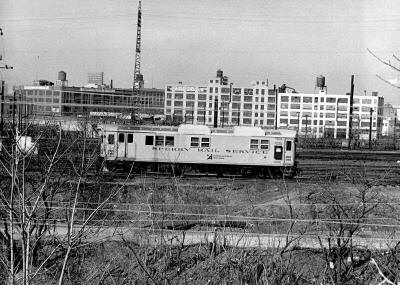 SRS #140 - Sunnyside Yard 2/28/1976 Archive: Extra 2200 South Locomotive Magazine |
||||||||||||||||||||||
|
|
|
|
|||||||||||||||||||||
|
Just
as other railroads have chosen, the
Instead, Sperry Rail Service would send a track inspection car to inspect LIRR rails annually. |
|||||||||||||||||||||||
|
|
The Sperry Ultrasonic Detector Car reaches the Montauk station after traveling 61 miles of track from Patchogue on Dec. 5, 1963. The Detector Car was leased to the LIRR for the day in order to electronically check for weak areas along the tracks. Two days earlier, a train had derailed near the Brookhaven station, injuring 20 passengers. (Newsday - Max Heine) |
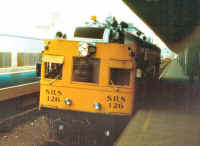 Sperry Inspection Car #126 Jamaica 3/1977 Photo: Tim Darnell |
|
||||||||||||||||||||
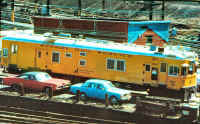 Sperry Inspection Car #118 Sunnyside Yard 4/1977 Photo: Tim Darnell |
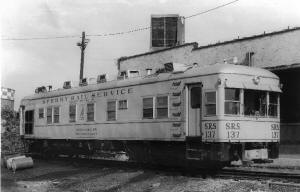 Sperry Inspection Car #137 at Jamaica (Ziel-Boland) |
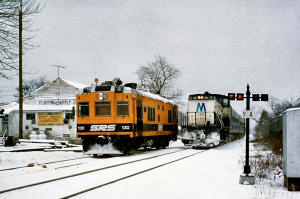 Sperry Inspection Car #130 at YA, Yaphank - View NE 2/2020 Photo: MTA/LIRR |
|||||||||||||||||||||
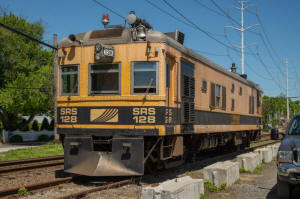 |
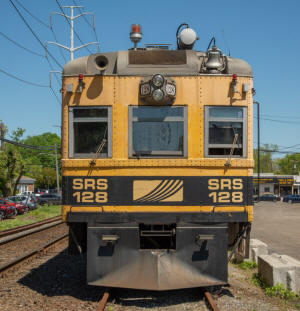 |
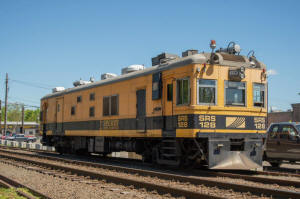 |
|||||||||||||||||||||
|
Sperry
#128 is making its annual tour of the LIRR and testing on the Port
Jefferson Branch while waiting out the weekend on the passing siding at
Greenlawn. Built by St. Louis Car and out shopped 9/1925 |
|||||||||||||||||||||||
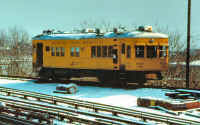 Sperry Inspection Car #126 Jamaica 3/1977 Photo: Tim Darnell |
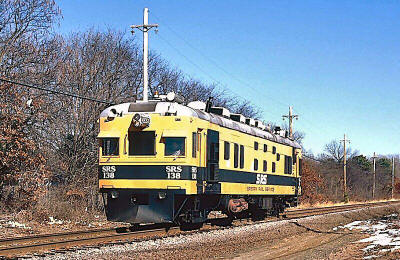 Sperry Inspection Car #138 at Ronkonkoma Photo/Archive: William Skeats |
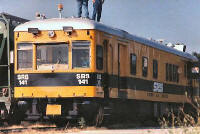 Sperry Inspection Car #141 at Pinelawn Photo: Steve Lynch c. 1990 |
|||||||||||||||||||||
T-18, Federal Railway Administration Gage Restraint Measurement System (GRMS) Vehicle - Smithtown 8/15/2006 Photo: John Volpi
|
T-18, (GRMS) Vehicle - Smithtown Photo: John Volpi 8/15/2006
|
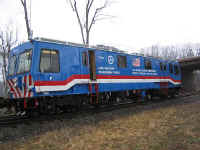 A state-of-the-art deployable GRMS vehicle which utilizes a 5th split railroad axle to laterally load the head of both adjacent rails of railroad track in order to measure rail motion under a combined vertical and later load for the detection of weak ties and fasteners. |
|||||||||||||||||||||
| Track Geometry Cars | |||||||||||||||||||||||
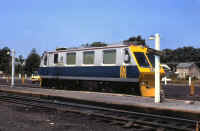 LIRR TC80 Greenport view NW 07/18/1977 Wm. J. Madden photo, Archive: Dave Keller 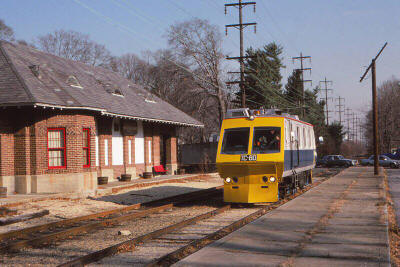 TC80 westbound Clinton Road Station 12/1985 Photo/Archive: Jay Bendersky
|
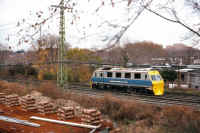 TC81 Grand Ave., Maspeth 12/03/1990 Archive: Dave Keller Before there was the TC82, there was the TC81 and before that, the TC-80! Here the TC-80 is proceeding west on the Garden Mitchel Secondary, going past the former Clinton Road Station, which is now Garden City Fire Department Station #3. 12/1985 Photo/Archive: Jay Bendersky
|
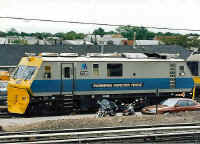 TC81, Plasser Track Geometry Car, Jamaica Station 1995 Photo: Phil Goldstein
|
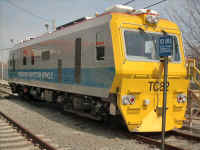 LIRR TC82 Track Geometry Vehicle |
||||||||||||||||||||
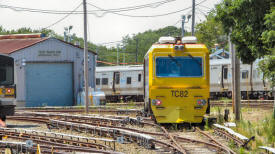 TC82 Babylon Yard - View NW 7/24/2022 Photo/Archive: Craig Lignelli |
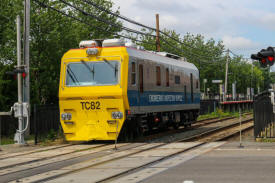 TC82 Port Jefferson Branch 7/25/2022 Photo/Archive: Craig Lignelli |
||||||||||||||||||||||
| Trackmobiles | |||||||||||||||||||||||

Rail King RK #285 - Arch Street 6/20/2025 Photo/Archive: Chris Kokonis |
|||||||||||||||||||||||
| Wreck
Train Cars |
|||||||||||||||||||||||
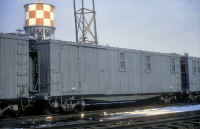 W-52
Class MWT, a tool and
block car. Mike Boland wrote that enthusiasts can model it in HO-scale
using Bethlehem Car Works' flat-pack plastic model of a B60. Other
MWTs were W-50, W-57, W-59, and W-60. W-52
Class MWT, a tool and
block car. Mike Boland wrote that enthusiasts can model it in HO-scale
using Bethlehem Car Works' flat-pack plastic model of a B60. Other
MWTs were W-50, W-57, W-59, and W-60.
W-52 Wreck Train Car at Morris Park 7/2/1966 (Rugen-Huneke) |
|||||||||||||||||||||||
| Acknowledgments | |||||||||||||||||||||||
| James Bradley's book provided me
with a great deal of general information on MofW
equipment. Fred Twombly of F & F Custom
Trains shared with his copy of a "Record of Work Equipment as of
|
|||||||||||||||||||||||
| Bibliography | |||||||||||||||||||||||
| Boland, Mike.
"Modeling LIRR Pennsy Class GR Gondolas"
Semaphore April 1993 page 6-7. |
|||||||||||||||||||||||
|
Track Maintenance Cars on the LIRR |
|||||||||||||||||||||||
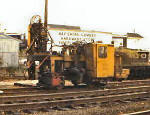 Fairmont Tie Inserter |
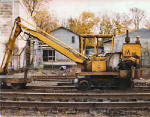 RTW Tie Handler |
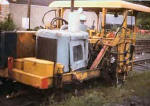 Spike Driver |
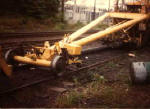 Track Leveling |
||||||||||||
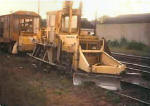 Kershaw Ballast Regulator (Spreader) |
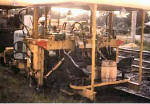 Spike Driver |
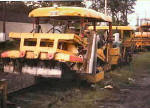 Nordberg Scarifier Cable Tie Inserter |
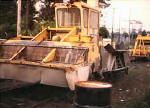 Kershaw Ballast Spreader |
||||||||||||
 Jet Engine Ice Melter Babylon Team Yard 2007 |
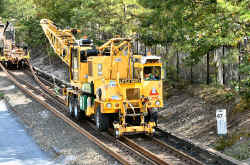 "Little Giant" Crane TC-904 - Mainline Double Track Project MP47 Ronkonkoma view SW 10/18/15 Photo: Edward Hand |
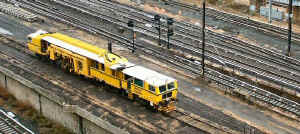 LIRR Plasser Unimat 09-164S, LI City View east 11/2007 Photo: Kevin Katta |
|||||||||||||
| Plasser American MOW | |||||||||||||||
| Distributing and Profiling the Ballast | Tamping the Ballast | Stabilization and Consolidation | |||||||||||||
|
Calverton - Edwards Ave. View E
|
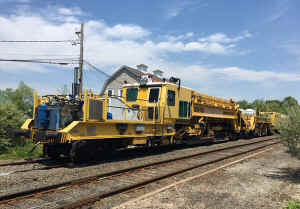 The Plasser Ballast Distribution System consists of two complete, separate units that can work together as one machine, or as two separate machines. The BDS-100 is equipped with a hopper for ballast storage, conveyors to distribute ballast and a fully adjustable x-type ballast plow, and unique shoulder plows to profile the ballast.
|
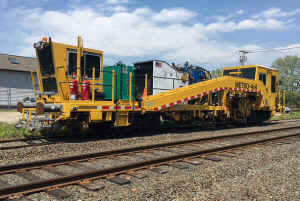
Plasser METRO 4x4 is a heavy-duty, high performance switch and production tamping machine specially designed for the stringent requirements of transit railway systems. It is standard equipped with fully automatic, computer controlled (AGGS) lifting, leveling and lining systems |
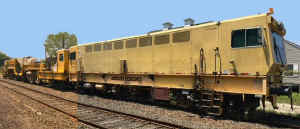
Plasser Dynamic Track Stabilizer PTS-62 is designed to apply controlled, accurate stabilizing forces into the track structure at continuous speeds of up to 1.5 mph. All track is subject to settling due to traffic loads. This settling occurs irregularly and uncontrolled, resulting in track deterioration. Dynamic track stabilization is a combination of horizontal vibration and a vertical load.
All photos: Calverton, NY 5/17/2017 Steve Rothaug
|
||||||||||||
|
|
|||||||||||||||
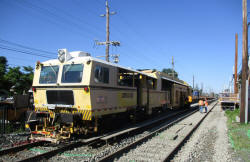 Plasser Unimat 09-16 4S #TC-034 New Hyde Park Rd. view W 7/12/2020 Photo: Dave Morrison |
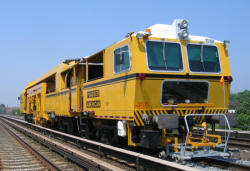 Plasser American Unimat 09-16 4S switch and production tamping #3215 |
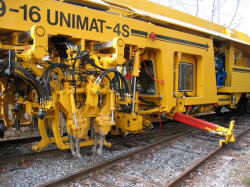 Plasser Unimat 09-16 4S LIRR #TC-033 |
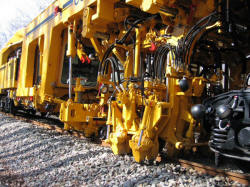 Plasser Unimat 09-16 4S LIRR #TC-033 |
||||||||||||
|
Plasser American Unimat 09-16 4S switch and production
tamping machine. The LIRR purchased two of these machines which were
delivered in 2005; #TC-033- 034. They are used to tamp the track while
correcting the track geometry; surfacing and alignment to improve the ride
quality for passenger confront and safety of keeping the trains on the
track. They have 16 tamping tools to “pack” the ballast under the ties and
are capable of production tamping on plain track as well as tamp switches.
Tamping switches requires being able to work around the rails as the
transition and all of the hardware in a switch to allow it to operate. This
is a 09 series tamper which means it has a satellite which contains all the
working components. During operation the satellite moves from tie to tie
while tamping while the mainframe moves in a continuous motion which allows
the machine to work at a higher production rate while reducing wear and tear
on the machine. |
|||||||||||||||
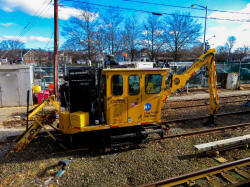
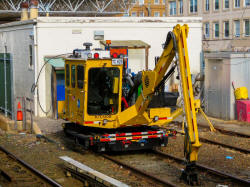 Knox Kershaw KTC1200 TC-629 at Port Washington track no.6 12/23/2021 Photos/Archive: Craig Lignelli |
 Plasser American TC-032 ballast tamper Photo/Archive: Jay Bendersky |
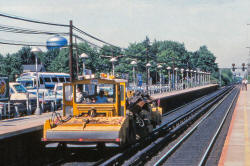 Plasser American TC-814 ballast regulator Photo/Archive: Jay Bendersky |
|||||||||||||
| "Fire Water Tank" Cars | |||||||||||||||
|
There is a tank car the LIRR owns, number 5001. I think there is now, or was, a number 5000 as well. It's actually believed that 3 tank cars used to exist for the purpose of fire suppression, but that would have to be confirmed with the Railroad for actual truth. I do have a friend that has a LIRR equipment roster updated as of 1994, so I may be able to check that and confirm myself, though the only car I know the whereabouts of is actually located in Speonk yard on the wye tail and has been there for months - and that is the 5001. It is painted black with white spray painted stencil lettering. When the wild fires occurred near Westhampton in the Pine Barrens, the #5000 was used to combat the flames. There is a gasoline powered pump located on that tank car which pumps water to the nozzle. I believe that the tank has to be filled for it to work. In other words, the car cannot be connected to a fire hydrant with the pump running because it won't work. It's capacity is 10,000 gallons and is used for water only. Joe Tischner 09/14/2006
|
|||||||||||||||
| Sandite - Alcohol Cars | |||||||||||||||
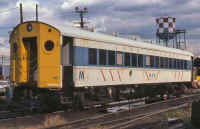 W84 MP54, ex LIRR 1691 Built 1920 at Morris Park 10/1977 |
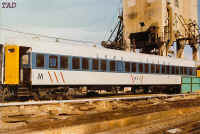 W85 P74B Morris Park 1/1979 Photo: Tim Darnell
|
|
|||||||||||||
|
Alcohol: Sandite: Alcohol/Sandite |
|||||||||||||||
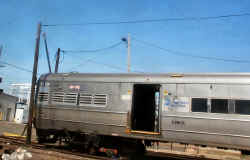 E901 4/04/2019 Morris Park Photo/Archive: Tim Darnell |
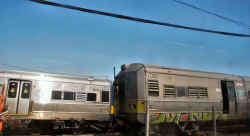 E401, E902 4/04/2019 Morris Park Photo/Archive: Tim Darnell |
The
LIRR currently uses two M-1 cars to "slime" the rails during
falling leaf season. Modified M1's 9401 & 9591 (now E401 & 591) are
utilized sandwiched between a pair of MP15's.They operate entirely at night
and are serviced at There are also leaf crusher trains. These consist of two
MP15's and gravel hoppers. They crush the leaves on the Both sandites and leaf crushers have run on
the branch simultaneously, and have been on the branch with both. Leaf |
|||||||||||||
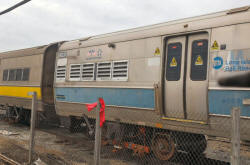 |
Spotted in Morris Park - M3 9869 has been converted to a work car, with a “new” number of E869. After losing its mate (9870) in a crossing accident, it was paired with 9772 until the most recent rounds of M3 scrapping. 9772 was taken off property, while 9869 seems to have been spared the torch by way of work service. (4/01/2024) Thomas Farmer
|
||||||||||||||
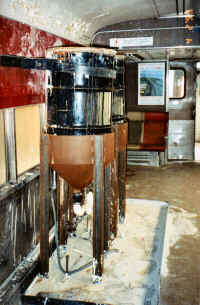 Sandite is a sticky, slimy goo stuff. These are a set of cars that were converted with large tanks inside used during the fall/winter. The cars drop the sandite on the railhead and it helps with traction. Alcohol is used on the 3rd rail to prevent freeze ups. A pair of these cars are out in KO, the one above, W85 and a P72. Both haven't been used in awhile. Now there are M1s used in place that have been converted. #2907 and #2909 are alcohol cars. Paul Strubeck Photo: Mario Craig
Leaves on the tracks can lead to slippery rail conditions.
view
LIRR/MTA video |
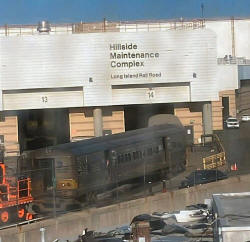 Hillside Maintenance Complex - Alcohol M1's E401 and E591, prior #9401, #9591 to be scrapped. 4/12/2023 Photo/Archive: Jake Rothman |
||||||||||||||
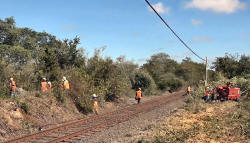 The LIRR MOW leaf control program trims and removes vegetation. Photo: 2016 LIRR/MTA |
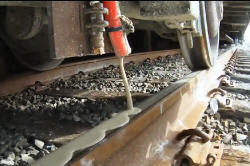 Sandite application - Photo: 2016 LIRR/MTA |
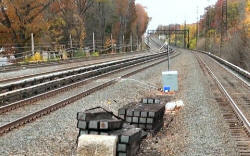 Lynbrook stationary Sandite applicator Photo: 2016 LIRR/MTA |
|||||||||||||
|
Crushed Autumn leaves create an oily residue, pectin,
causing wheel slip and slide. This slip-slide creates wheel flat spots and
track damage. Wheels must be taken out of service for reshaping,
termed truing. |
|||||||||||||||
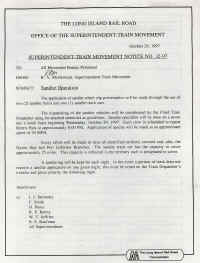
|
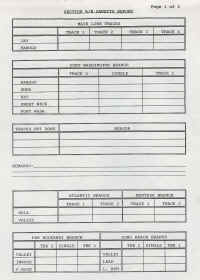
|
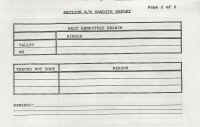
General Orders issued 10/29/1997 on the utilization of Sandite Operations by R. A. McDermott, Superintendent of Train Movements. Info: Chris Soundy, Paul Strubeck Archive |
|||||||||||||
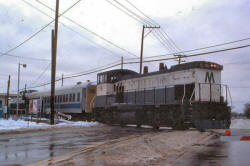 Alcohol train LIRR #157-162 W85 Bethpage c.1989 Photos: John61 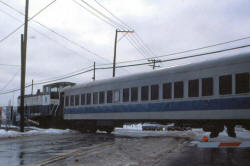
|
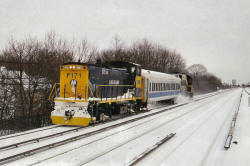 Alcohol train LIRR #171 2/12/1994 W85 at KO - Photo/Archive: LI Joe  LIRR #160 alcohol train westbound passing Deer Park - 2/06/2025 Photo/Archive: Ronnie Schnepf |
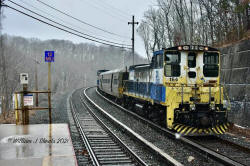 Alcohol 2 train heading to Huntington at Cold Spring Harbor 1/26/2021 - Photo/Archive: William Skeats |
|||||||||||||
| Laser Train | |||||||||||||||
|
Power wash travel is 2x faster with increased pressure
washing by 400%. Laser technology decreases wheel slip traction
problems caused by fallen leaves |
|||||||||||||||
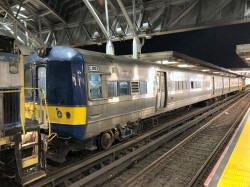 M3 E902 laser car 11/14/2020 Archive: Brian Lee |
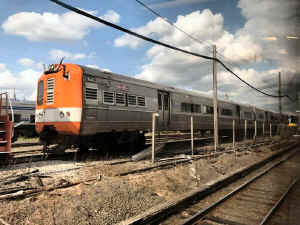 M3 ex-9775 converted to #E775 laser car - 2018 Photo/Archive: Jeff Erlitz |
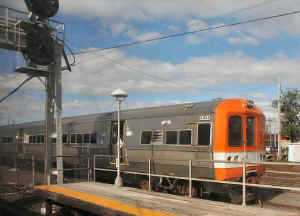 M3 ex-9932 converted to #E932 at Jamaica 10/12/18 - Photo/Archive: Tim Darnell |
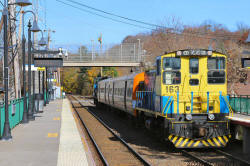 MP15 #163 and #161 Laser train at Roslyn 11/15/2020 Photos/Archive: Daniel Foran 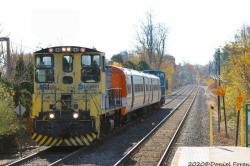 |
||||||||||||
Choo Choo, Pew Pew: How a New York Railroad Uses Scorching
Lasers to Stay on Schedule
|
|||||||||||||||
11/25/2025